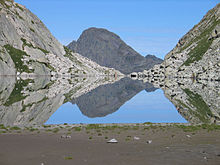Ibon
Ibón is the term in the Aragonese language, which when passed into Spanish has been relegated to denominate the small mountain lakes of glacial origin located in the Aragonese Pyrenees, from the area of the Ansó valley to the surroundings of Tuca del Aneto. In the Aragonese language its meaning is more general, used to name any lake or pond. For example, in the city of Huesca, the fountain with the longest tradition is called "Fuente del Ibón".
Etymology
The word ibón is a word from the ancient Aragonese pre-Roman language, linguistic substratum of the later Romance (language from which it retained some words such as "chordón" or " caparra", and that it was probably Basque), related to the Basque "ibai" (river), and originally served to designate the sources whose waters gush; When the land where the spring is located forms a glass, these waters give rise to larger or smaller lakes, depending on the orographic characteristics of the land where the spring is located.
Its root would be in the word "ip" or "ib", as attested by the Ibón of Ip.
They are "censused" a total of 197 lakes of very different sizes and shapes; some are used to power small hydroelectric plants.
There are enchanted lakes, where, according to local legends, "live" fairies, like that of Plan. Other known lakes are those of Anayet, Sabocos, Ip and Estanés.
It is equivalent to the Occitan estanh and the Catalan estany to refer to the same geographical feature.
Training
Most of the lakes are geologically recent formations, arisen by glacial excavation processes, approximately 30,000 years ago in the ice age, having occurred, in the post-glacial period, the disappearance of some, and the erosion of the mountain, that has expanded or reduced their extension, and modified the places in which they are located.
Waters
The water of the lakes is sweet, since it comes from the melting of the snow. In fact, the lakes have been studied by different associations, determining that their waters are of high quality. Although the lakes are places little traveled by people on a daily basis, some uncivil hikers throw waste in the environment, dirtying them; Thus, in different cleaning campaigns, large garbage bags have been filled with waste such as canned food or soft drinks, plastic bottles and bags, and other objects thrown into the lakes. Every year some lakes are cleaned of these wastes, since they prevent the development of life and cloud the waters of the lake.
Another of the conditions of anthropic origin of the lakes is the presence of fish. Naturally, most of the lakes have no direct connection with the river courses inhabited by the ichthyofauna. The fish that are in them are introduced by the fishermen in such a way that they become predators that feed on everything they find, mainly the roe of the amphibians and the spawnings and clutches of the invertebrates that do have the lake as their natural habitat, unbalancing the aquatic ecosystem of these lakes.
Most of the lakes are in protected areas, and according to Aragonese legislation bathing, water activities and navigation are prohibited. The consumption of its waters should not be recommended, due to their low salinity.
Climate and morphology
The water in the lakes is usually quite cold because they fill up with melting snow; in almost all of them, the temperatures are of the order of 4 °C. Even in the summer months, many lakes remain frozen or have shallow ice sheets. On the other hand, the depth of the lakes varies by area. There are shallow lakes, less than 0.5 m, and there are those that are more than 25 m deep. This is the case of the Sabocos or Tebarray lakes.
Contenido relacionado
Annex: Municipalities of the province of Las Palmas
1471
Villagelanguage



